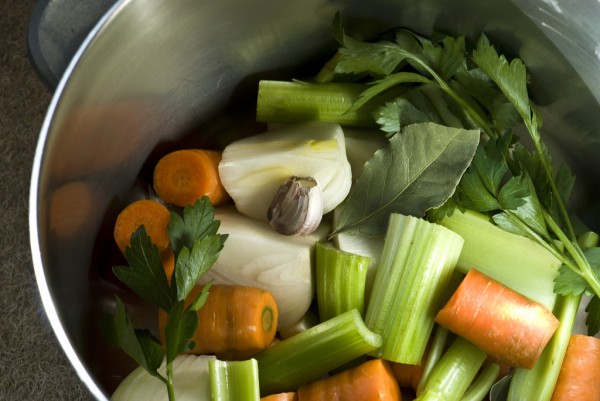Stocking Up: Uncovering the Secrets to the Best Broth
What do the experts recommend you do to get the most flavorful soup possible?
![]()
In winter, a home cook is only as good as her latest soup stock. This year it has become a bit of an obsession for me. I keep finding myself washing mason jars I have recently emptied of stock just in time to fill them with more of this golden liquid.
As with most cooking, however, I’ve been more or less winging it. So I decided to ask a few real life experts about what it takes to step up my soup stock game. Here’s what I learned:
1. Plan for balance
“I see a lot of people add vegetables to a pot willy-nilly and then end up with a really oniony tasting liquid, which isn’t horrible, but doesn’t necessarily make a great soup,” says Tamar Adler, author of An Everlasting Meal: Cooking with Economy and Grace. The goal, says Adler, is to be creating a great soup from the beginning. This means adding a balance of celery, carrots, and onions, as well as a good-sized collection of bones.
2. Collect a critical mass of ingredients
Writer and chef Samin Nosrat makes stock in large batches. “All month long I save onion ends, the last bit of celery, carrots, or the end of a bunch of parsley or thyme in my freezer.” She sees this habit as, “compiling something of a stock kit, so when it’s time I can just pull everything out of the freezer, stick it in a pot, cover it with water, and bring it to a boil.”
3. Don’t treat your stock fixings like a compost pile
Not everything adds to the flavor of a stock. It’s a good idea to stay away from all brassicas (i.e. broccoli, cauliflower, etc.) because they tend to add a gassy flavor. And while parsley stems add a pleasant savory flavor, woody rosemary and thyme stems often impart a bitterness, if any flavor at all. And while stock ingredients need not be beautiful, you’ll want to make sure they haven’t started to rot, either. “If you wouldn’t eat it, why put it in stock?” says Preeti Mistry, former Top Chef contestant and chef at Oakland, Calif.’s soon-to-open Juhu Beach Club.
4. Try a two-for-one approach
Most stock starts with leftover bones and trimmings, making it a great way to prevent food waste and an economical choice for home cooks. But some techniques create delicious stock and delicious meat entrees all at once. In fact, Adler’s favorite kinds of stock come about this way. In a conversation with chef Josh Lewin on the Slow Food USA website, Adler described the benefits of this approach. “If you boil or braise meat, you end up with broth or with braising liquid – whatever combination of vegetables and wine and water or stock the meat cooked in. That means that you have the meat itself for a meal or several, and then the beginnings of a soup, or several. It doubles the number of meals you get for your money and the time you’ve spent cooking.”
5. Roasting brings out flavor
It’s common to roast beef bones before making stock, but Mistry also likes to roast chicken bones on their own until there are a “a nice, dark caramel color” before using them in a stock. She also likes to add roasted bones to store-bought stock as a way to double up on flavor, especially if she or one of her loved ones are fighting a cold. “When I’m sick I want to make a stock that’s really intense,” she says.
6. A little raw meat is good too
Nosrat also stashes raw bones and chicken parts, like heads and feet in her freezer to add to the pot alongside roasted chicken carcasses. “Raw parts (and those parts in particular) are so rich in gelatin, adding a lot of body,” she says.
7. And now for the extra magic
One popular, unexpected stock addition is the green, leafy tops of fennel bulbs (collect them in the freezer along with the other vegetable bits). Parsnips can also provide an interesting twist. Bay leaves and peppercorns are another common additions. Nosrat says she also occasionally adds a tiny splash of vinegar. “I learned from the nonnas that it helps to extract calcium and other nutrients from the bones,” she says.
8. Cook it. Cook it real good.
The best way to build flavor in stock is to cook it at the lowest simmer possible for several hours. But can you simmer it for too long? That depends on whom you ask.
“I usually start stock after I cook dinner … and leave it on the stove overnight (at least six hours),” says Nosrat. And she’s not alone in this approach. Many chefs leave stock simmering in the background while doing other things.
But Adler has another, more precise approach. “When you taste the vegetables and they don’t taste like anything anymore, they’ve done all they can for the stock,” she says. The danger, Adler believes, is that “the flavors start to get over-cooked and muddy.” Instead, at that point, Adler thinks it’s a good idea to strain your stock. If you want it to be more distilled, you can just let the strained stock cook longer on its own.
